InTheSwamp
Member
9mm is just fine.I have a XDM E compact also. Like it so far!
I will probably stay with a 10mm because of its versatility. Only CCW against two legged threats? I would go with a 9mm for more capacity and micro compact options.
9mm is just fine.I have a XDM E compact also. Like it so far!
I will probably stay with a 10mm because of its versatility. Only CCW against two legged threats? I would go with a 9mm for more capacity and micro compact options.
How funny is it that your post is #40 in this thread?The biggest issue with the FBI not going with 10mm wasn't recoil, the load they used was effectively a typical .40 S&W level loading, but rather the size of the gun itself. That's pretty much the reason .40 even exists at all, as it's able to give good performance from a 9mm sized handgun.
I have and shoot both .40 and 10mm and I'll say that if I had to choose just one, I'd pick .40 every time. That's not to say that I don't like 10mm, I have some nice guns chambered in the 10mm, but for carry purposes and really also for home defense, I always felt the .40 was essentially the perfect option. You do get more power with 10mm, but that comes at the cost of a bigger gun. While on the topic of power, I have two points. One, if I really need more power than .40 S&W, I'll likely grab the .44 Mag Ruger or S&W, although the .40 will work for deer sized game. Second, and this point is somewhat controversial, is that while the 10mm is more powerful, I don't feel that it's "far more" powerful. I say this because I've ran warm handloads through both and realistically the 10mm has about a 100 fps advantage over the .40, give or take ~25 fps depending on a heavy bullet vs. light bullet.
More is more, no doubt, but how much difference does that make in the long run? The 10mm is a very good and versatile option, but it gets praise while the .40 gets scorn. That doesn't make sense to me, as people often (in this very thread) want a 10mm sized G23, yet if one did exist, it wouldn't be appreciably better than the G23 already is. I can run a 180gr @ 1350 fps from a 5" 10mm and guess what, it'll work in the woods. But guess what else? So will factory level .40 S&W loads. If I can load a 180gr @ 1250 fps from a 5" .40 S&W, I guess I have to wonder what the 10mm really gives me, you know. It's more powerful but is it really that much more capable? But okay, I don't want to step on too many toes here so I'll quiet down a bit. I do get why the 10mm is popular, and that's because you can buy warmly loaded 10mm and have it shipped to your door, so really you don't need to handload to get a certain level of performance from your gun (whereas you do with .40)...basically it's just more convenient.
10mm: A larger and faster round, with similar bullet weight (sometimes heavier if 200gr+ ammo) compared to .40. In average ccw sized guns (say 4" barrel or less), the ballistics can be strikingly similar compared to .40, but generally more penetration and expansion. Also, more RECOIL, and potentially MUZZLE FLASH in general. This means harder to shoot, slower follow-up shots, more chance of flinching, higher risk of a complete miss, etc., compared to .40. Generally, increased risk of over penetration compared to .40. Also can make a slightly heavier ccw setup than a .40 setup, due to slightly heavier guns and ammo.This definitely packs a wallop, more than .40 generally can, but at a COST.
Example: Glock 29 (Standard mag capacity of 10 rounds/3.78" Barrel).
*Results from Glock 29/3.78" Barrel)*
Ammo: 180gr Buffalo Bore JHP @ 1269 FPS/644 Ft-Lbs Energy (5-Shot Avg). 18.36" Penetration/0.7" Expansion (5-shot avg).
View attachment 1171330
.40: Very similar to 10mm, but generally less power (ft-lbs energy), expansion (similar in a lot of cases), penetration (this is where 10mm has the most notable advantage over .40 in my opinion, possibly even to a fault, i.e.10mm edging a little too close for comfort into over penetration risk territory), and LESS RECOIL and LESS MUZZLE FLASH, in general. Likely to come in a lighter ccw package than 10mm due to gun and bullet weight.
Generally, it's easier to shoot, offers quicker follow up shots, less muzzle flash, basically makes it easier to achieve good shot placement, less risk of over penetration, and a very proven round. Let's not forget how capable of a round .40 is, with loads getting more expansion and penetration than the BEST 9mm loads. A 0.67" hole on the deeper side of FBI penetration standards (15"+)? Ask yourself, realistically, how much more do you really need?
Example (s): Glock 23 (Standard mag capacity of 13 rounds/4.02" Barrel).
Smith and Wesson M&P40c (Standard mag capacity of 10 rounds/3.5" Barrel).
Ammo:
*Results from M&P40c/3.5" Barrel*
180gr Winchester Defender Bonded JHP @ 979 FPS/383 Ft-Lbs Energy (5-shot avg). 17.02" Penetration/0.67" Expansion (5-shot avg).
View attachment 1171331
In conclusion, the main disadvantages of 10mm compared to .40, and why, in my opinion, 10mm is not better for the VAST majority of people for ccw/self-defense against humans, is....
- Higher chance of over penetration compared to .40. I guess this is why 10mm is highly routed for use against animals, but this goes away from the focus of this thread, which is humans.
- In general, more recoil, muzzle flash, and noise than .40. In an average ccw sized package, 10mm ammo self defense ammo seems downright obnoxious. And the more you lessen the power of a normal 10mm load, guess what cartridge it's becoming more and more like... If one can "handle" 10mm, especially in a ccw sized package, how much better a .40?
- More chance to completely MISS, compared to .40!
(In my opinion) When it comes to defending against humans, 10mm makes for an unnecessarily obnoxious ccw/self-defense platform when compared to the .40. Also, it seems to border the power/penetration limits for safe usage in ccw/self-defense situations, against other people, to unnecessary limits.
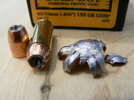
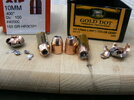
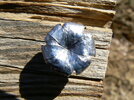
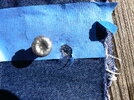
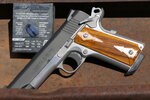
Correct.I'd take a 10 mm all day long. Ammo selection helps mitigate some of the concerns. You can get soft shooting, less penetrating 10 mm ammo for dangerous 2 legged critters or heavy hitting, more penetrating 10 mm ammo for larger, dangerous 4 legged critters.
Basically, a 10 mm can do what a .40 S&W can do, but not the other way around.
10mm: A larger and faster round, with similar bullet weight (sometimes heavier if 200gr+ ammo) compared to .40. In average ccw sized guns (say 4" barrel or less), the ballistics can be strikingly similar compared to .40, but generally more penetration and expansion. Also, more RECOIL, and potentially MUZZLE FLASH in general. This means harder to shoot, slower follow-up shots, more chance of flinching, higher risk of a complete miss, etc., compared to .40. Generally, increased risk of over penetration compared to .40. Also can make a slightly heavier ccw setup than a .40 setup, due to slightly heavier guns and ammo.This definitely packs a wallop, more than .40 generally can, but at a COST.
Example: Glock 29 (Standard mag capacity of 10 rounds/3.78" Barrel).
*Results from Glock 29/3.78" Barrel)*
Ammo: 180gr Buffalo Bore JHP @ 1269 FPS/644 Ft-Lbs Energy (5-Shot Avg). 18.36" Penetration/0.7" Expansion (5-shot avg).
View attachment 1171330
.40: Very similar to 10mm, but generally less power (ft-lbs energy), expansion (similar in a lot of cases), penetration (this is where 10mm has the most notable advantage over .40 in my opinion, possibly even to a fault, i.e.10mm edging a little too close for comfort into over penetration risk territory), and LESS RECOIL and LESS MUZZLE FLASH, in general. Likely to come in a lighter ccw package than 10mm due to gun and bullet weight.
Generally, it's easier to shoot, offers quicker follow up shots, less muzzle flash, basically makes it easier to achieve good shot placement, less risk of over penetration, and a very proven round. Let's not forget how capable of a round .40 is, with loads getting more expansion and penetration than the BEST 9mm loads. A 0.67" hole on the deeper side of FBI penetration standards (15"+)? Ask yourself, realistically, how much more do you really need?
Example (s): Glock 23 (Standard mag capacity of 13 rounds/4.02" Barrel).
Smith and Wesson M&P40c (Standard mag capacity of 10 rounds/3.5" Barrel).
Ammo:
*Results from M&P40c/3.5" Barrel*
180gr Winchester Defender Bonded JHP @ 979 FPS/383 Ft-Lbs Energy (5-shot avg). 17.02" Penetration/0.67" Expansion (5-shot avg).
View attachment 1171331
In conclusion, the main disadvantages of 10mm compared to .40, and why, in my opinion, 10mm is not better for the VAST majority of people for ccw/self-defense against humans, is....
- Higher chance of over penetration compared to .40. I guess this is why 10mm is highly routed for use against animals, but this goes away from the focus of this thread, which is humans.
- In general, more recoil, muzzle flash, and noise than .40. In an average ccw sized package, 10mm ammo self defense ammo seems downright obnoxious. And the more you lessen the power of a normal 10mm load, guess what cartridge it's becoming more and more like... If one can "handle" 10mm, especially in a ccw sized package, how much better a .40?
- More chance to completely MISS, compared to .40!
(In my opinion) When it comes to defending against humans, 10mm makes for an unnecessarily obnoxious ccw/self-defense platform when compared to the .40. Also, it seems to border the power/penetration limits for safe usage in ccw/self-defense situations, against other people, to unnecessary limits.
I like 40 and really like my Glock 22.5
That said, I do not think penetration & expansion in gel completely reflective of ASAP incapacitation potential.
An example that mostwillshouldmight understand:
https://www.luckygunner.com/labs/revolver-ballistics-test/
4'' barrel Remington 125 SJHP 357 Mag - 13.6'' / .54 - 1,473 fps - 602# KE
4'' barrel Remington 158 LSWCHP +P - 13.4'' / .56 - 921 fps - 298# KE
Penetration & expansion in gel is near identical for those two bullets.
I (and probably most other people) think 357 Mag has better ASAP potential than the 38 special - it has 2x the KE.
Overpenetration? Pick the right bullet.
https://www.luckygunner.com/labs/10mm-auto-self-defense-ammo-ballistic-gel-tests/
Hornady 155 XTP - 14'' / .68 - 1,344 fps - 622# KE
Hornady 180 XTP - 16.9'' / .64
Winchester Silvertip - 16.2'' / .68
None of those are over penetrative.
Now to tie back to my 357 vs 38 example.
https://www.luckygunner.com/labs/self-defense-ammo-ballistic-tests/
Federal 165 gr. Tactical Bonded - 14'' / .73 - 978 fps - 350# KE
If we think the 357 Mag has better ASAP potential than the 38 Special - then we must apply the same to this 10mm vs 40 example.
I can't quantify it, but I think the 10mm has better ASAP incapacitation potential than the 40 - same shot placement is assumed.
Denial - is neither fact nor explanation.
Given equal expansion and complete penetration?
Yeah … but you’re applying logic.Look at the 10 mm bullets I posted above from Lucky Gunner testing; none of those are over penetrative and would be good for self defense against human attacker(s).
Also looking at the 38 special versus 357 Mag example, if we think 357 Mag has better ASAP potential than 38 special, most people do...
Apply that to 40 vs 10mm example above. If one thinks 357 Mag has better ASAP potential than 38 special then in the 40 vs 10mm example its the same thing.
The 357 also gains a little more as the barrel length increases, if you go to the extremes this is very evident from a Carbine length barrel the 357 has a good advantage, but from a snub nose the 357 is really closer compared to my similar size Walther PPS in 40.10mm and .357Mag are pretty much identical whether you like power factor/momentum or energy as a measure. 10mm has a slight advantage in momentum/power factor with very heavy bullets, .357Mag has a slight advantage in energy with very light bullets, but trying to pick a winner is going to require something other than looking at pure terminal ballistics.
Only if you can guarantee that you will never have to shoot more than once in a self-defense encounter or that there will be no time constraints on how long it takes you to make the second shot....what I can get faster follow up shots with is really garbage when it comes to me choosing a handgun to carry.
Sure. But that doesn't mean that they can shoot them all with exactly the same level of performance. There's no one in the world who can shoot a .50AE pistol just as fast as they can rip off accurate rounds with a 9mm. It's just not happening. That's why they categorize guns by recoil (power factor) in many competitions--to prevent people from getting an unfair advantage by going with a lower recoil round.This is a board filled with experienced shooters that are comfortable and very proficient with shooting .44 mags, 50AE, 454 Casul and a 10mm is a fun little pop gun to play with.
True enough. But if there's a need for a second shot (e.g. a second attacker), how long it takes you to get off another shot to deal with the second threat can be absolutely critical. Also, people miss in gunfights. Sometimes they get injured, sometimes they are moving while the target is moving at the same time, sometimes during movement barriers can get in the way. If that happens, again, getting off the next shot in a timely manner is pretty important.The chances of missing with a 10mm vs a 40 cal are the same for me.
Apparently that's true. Having to fire a second, or maybe a third or fourth round in a self-defense encounter is a far cry from a running gunfight shooting hundreds of rounds.Running through the ship yards engaging in a shootout with the evil South Africans, shooting hundreds of rounds of ammo, makes for a good movie but there are too many people that are not able to differentiate the movies or their favorite video game from real life.
Look at the 10 mm bullets I posted above from Lucky Gunner testing; none of those are over penetrative and would be good for self defense against human attacker(s).
Also looking at the 38 special versus 357 Mag example, if we think 357 Mag has better ASAP potential than 38 special, most people do...
Apply that to 40 vs 10mm example above. If one thinks 357 Mag has better ASAP potential than 38 special then in the 40 vs 10mm example its the same thing.
They also, of course, produce a temporary cavity. There's no question that they do, it can be easily documented. The contention is that the temporary cavity can not be counted on to produce a reliable wounding effect in terms of damage to vital organs. Again, that is true. That doesn't mean they NEVER damage vital organs, just that it's not a reliable effect. Some organs can't stretch much without tearing and can be severely damaged by temporary cavity/tissue stretch--even from a handgun. The liver, kidneys, spleen and brain are some examples. Some organs are pretty stretchy and temporary cavity/tissue stretch will have no significant wounding effect on them. Obviously, if an organ that is susceptible to temporary cavity damage is close to the bullet track, the larger the temporary cavity is, the more likely it is to damage the organ, and the more severe the damage is likely to be.And, as we know, handgun velocity bullets only produce permanent wound cavity damage, the crush channel of the expanded bullet.
They also, of course, produce a temporary cavity....
I carefully explained the detriment.With no detriment.
Some organs stretch and return. Some organs do not stretch, they tear instead which does cause wounding. Here's some more information on the topic.That's why they are called temporary, as the tissue stretches and then returns.

That is incorrect --as I've explained.Only the crush channel of the expanded bullet, at handgun velocities, does any appreciable damage.
The ATK engineers correctly note that at rifle velocities, even the elastic tissue can tear and be wounded. They are wrong about temporary cavity not causing any wounding at all with handgun rounds because they don't take into account that not all organ tissue is elastic. If you try to stretch a kidney, it will tear, not stretch. Same with a spleen, same with a liver. You can verify this if you really care about the topic. The issue is that if those inelastic organ are not close enough to the bullet path to be affected by the temporary stretch cavity, then the temporary stretch cavity will not have any wounding effect at all. So it's very true to say that temporary cavity is not a reliable wounding effect in handguns, but it's not correct to say that it can't ever have any wounding effect at all. If you go back to the original source of this information, you will see that it most often makes the statement that "Temporary cavity has no reliable wounding effect in elastic body tissues..." but the word "reliable" is often dropped when the quote is restated. Here's an example.Check with the ballistic engineers at ATK on this.
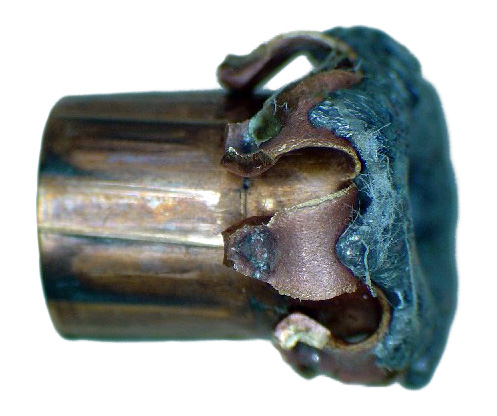
 www.gunnuts.net
www.gunnuts.net
I carefully explained the detriment.
Some organs stretch and return. Some organs do not stretch, they tear instead which does cause wounding.
It's not just if they are hit, it's if they are within the temporary stretch cavity extent. Larger temporary stretch cavity means that it's more likely to impinge on a vulnerable (inelastic) organ and that the vulnerable organ is likely to suffer more damage....similar damage to those few organs also prone to stretch damage if hit.
Perhaps, perhaps not. It depends on the size of the temporary stretch cavity and the bullet's path. The bottom line is that it is incorrect to say that temporary cavity has no wounding effect with handgun bullets. Clearly it CAN have a wounding effect and the paper I posted has the proof. It just doesn't have a reliable wounding effect because in some cases it doesn't cause wounding while in others it does.An exception to the rule, that will be affected by either expanded 10mm bullet.
Look at the pictures in the paper I posted. That is actual damage to actual organs. Done by a 9mm FMJ.Academic arguments - are just that.
It's not just if they are hit, it's if they are within the temporary stretch cavity extent.
Potentially a lot in some cases--nothing in many cases.By what significant factor, given a 150 fps impact velocity increase over an equally expanded .40S&W?
It depends entirely on the path the bullet takes through the target. Just as the "fight-ending significant damage" done by crush channel depends entirely on the path the bullet takes through the target.And, even then, what fight-ending significant damage, compared to the identical crush channel?
Hah! So based on one's personal opinions, one probabilistic effect (the odds that an overpenetration might hit something important) is significant, but another probabilistic effect (the odds that temporary cavity might impinge on an organ that could sustain significant wounding from it) is not significant. If only it were that simple. We could all win at the casinos every time by holding the personal opinion that one probabilistic outcome (winning) is more significant than another probabilistic outcome (losing).The collateral damage, however, from over-penetration, might be significant.
Anyway, the bottom line is that temporary cavity can definitely be shown to have a significant wounding effect in some cases.
Thanks, I remember what the thread is about.The thread is RE: .40S&W v. 10mm for CCW/SD.
The point is - both the .40S&W and 10mm are the same caliber, and will expand and completely penetrate even a large 10" torso.
And, as we know, handgun velocity bullets only produce permanent wound cavity damage, the crush channel of the expanded bullet.
So support your argument.


